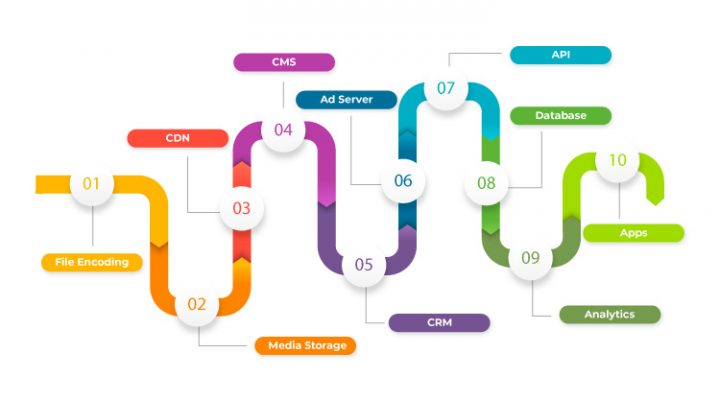
| Author: Kamlesh Kumar | Published: 19-Oct-2021 |
What Is OTT?
Quite simply, OTT is direct to consumer TV that sits atop cable. OTT enables live on-demand TV via connected devices like smart TVs, Amazon Fire TV, and Apple TV, among others.
OTT Benefits to provider
OTT has enabled a level of understanding of viewer behaviour that was just not possible with traditional TV. It allows providers to create ever more personalized content, thus increasing engagement, and enabling high ROI advertising too. Netflix—considered the gold standard of OTT—shows how understanding of TV user behaviour can be leveraged to create a strong and loyal customer base.
Milestones along the OTT Tech-journey
File Encoding and Transcoding: Wherein raw media files are converted from source format into suitable formats and uploaded
Media Storage. Where processed videos are stored, ready for delivery
Content Delivery Network (CDN): To enable quick delivery with 100 % uptime and redundancy of files.
Content Management System (CMS): For storage and organization of content, so it can be seamlessly shared online in different platforms
Customer Resource Management (CRM): Customizable platforms that can be tailored to improve customer targeting, personalize content, manage traffic and ease user interaction—including payments and feedback
Ad Server: For selecting and delivering suitable ad content—pre-rolls, mid-rolls and post rolls—at the proper time
Application Programming Interface (API): To provide the needed data in real time to load the home screen and deliver the content
Databases: To enable basic create-read-update-delete (CRUD) protocols for storing and cross platform viewing
Analytics: For granular understanding of content consumption, critical to be able to personalize content
Apps: To bring all the above together near-instantaenously to enable low latency, high-quality television viewing experiences
OTT Challenges
OTT solutions cannot be a one-size-fits-all solution: it needs to be flexible across the supply chain and, if needed, enable easy integration with partner services
Large IT teams: In order to meet individual service providers’ demands
Fragmented market with multiple types of devices, each requiring knowledge of a different programming language
Diverse workflows: Each media brand has its won unique method of managing content, ads, and meta data
AWS’s under-one-roof solution to your OTT Tech-stack needs
AWS tech stack, as outlined, below smoothens delivery all along the OTT journey
Amazon Simple Storage Service (S3)
S3, gives you server-side control over application. It enables storage and availability of files needed by TV apps to run. By storing UI configuration files, and creating buckets, with data specific to each one’s intended use, apps can smoothly request a particular file, load data, and draw the screens as instructed.
Amazon CloudFront
CloudFront (AWS’s content delivery network) sits on top of the S3 buckets. Not only does it ensure redundancy, it makes sure of availability of requested resources in our S3 buckets.
Amazon Elastic Cloud Computing (Amazon EC2)
OTT requires massive computing power but not continuously. The cost of maintaining servers indefinitely for this can be cost prohibitive. EC2 instances address this nicely, by providing virtual servers that can be created and terminated once their specific jobs are completed.
AWS Lambda and Serverless
Lamda allows APIs to communicate with front end application seamlessly. It allows the provider to query databases, process data and complete automated jobs as required. Since Lambda functions can be coded in multiple languages, development teams hit the ground running, using familiar knowledge on new technology. Best of all, as Lamdbda is a Serverless architecture, it eliminates the effort and expense of building and maintaining infrastructure, while enabling unrestricted scalability of APIs
Amazon DynamoDB
Fast, efficient, and powerful, DynamoDB—a “NoSql,” non-relational database—utlizies key value pairs instead of traditional database tables. It enables flexibility to scale without worrying about underlying infrastructure.
Looking Ahead
The secret to success in the OTT marketplace is personalization, and here data holds the key, not only to understand how services are performing but also to improve the overall experience for the consumer. Furthermore, insights mined from data also guides ad-serving, allowing advertisers to match and send best-fit ads to the right person at the right time, for higher ROI.
Technology advances in machine learning, and artificial intelligence will further raise the bar of personalization, giving granular understanding of audiences in a highly competitive marketplace.
The future of content consumption is clearly OTT. Traditional cable is all but passe.
OTT has reinvented the way content is both consumed and delivered, It is a game changer to content creators across the board—not just the big players but even small, niche creators aiming at a particular niche. It enables personalization like never before, allowing advertisers to match ads to user in a way that keeps both users and advertisers happy. Machine learning and artificial intelligence promise to further refine these capabilities.
And AWS offers the tools, infrastructure spread and innovation muscle they need to roll out sophisticated products and services, quickly, scalably, and cost-effectively.
 close
close

Hi there! At TeleGlobal, we turn your cloud vision into AI-accelerated reality. What challenge can we help you solve?
Powered by ![]() teleBot
teleBot